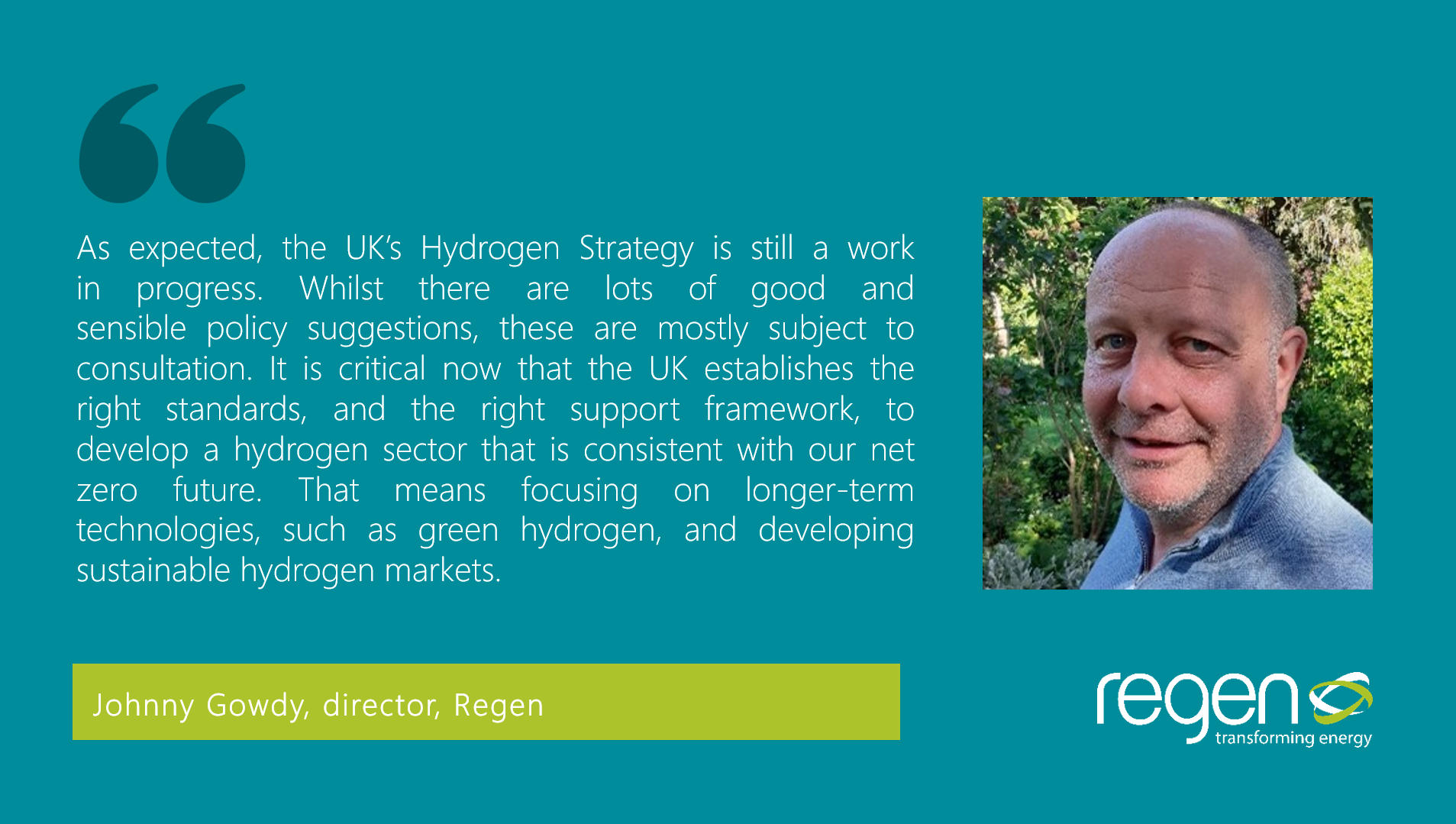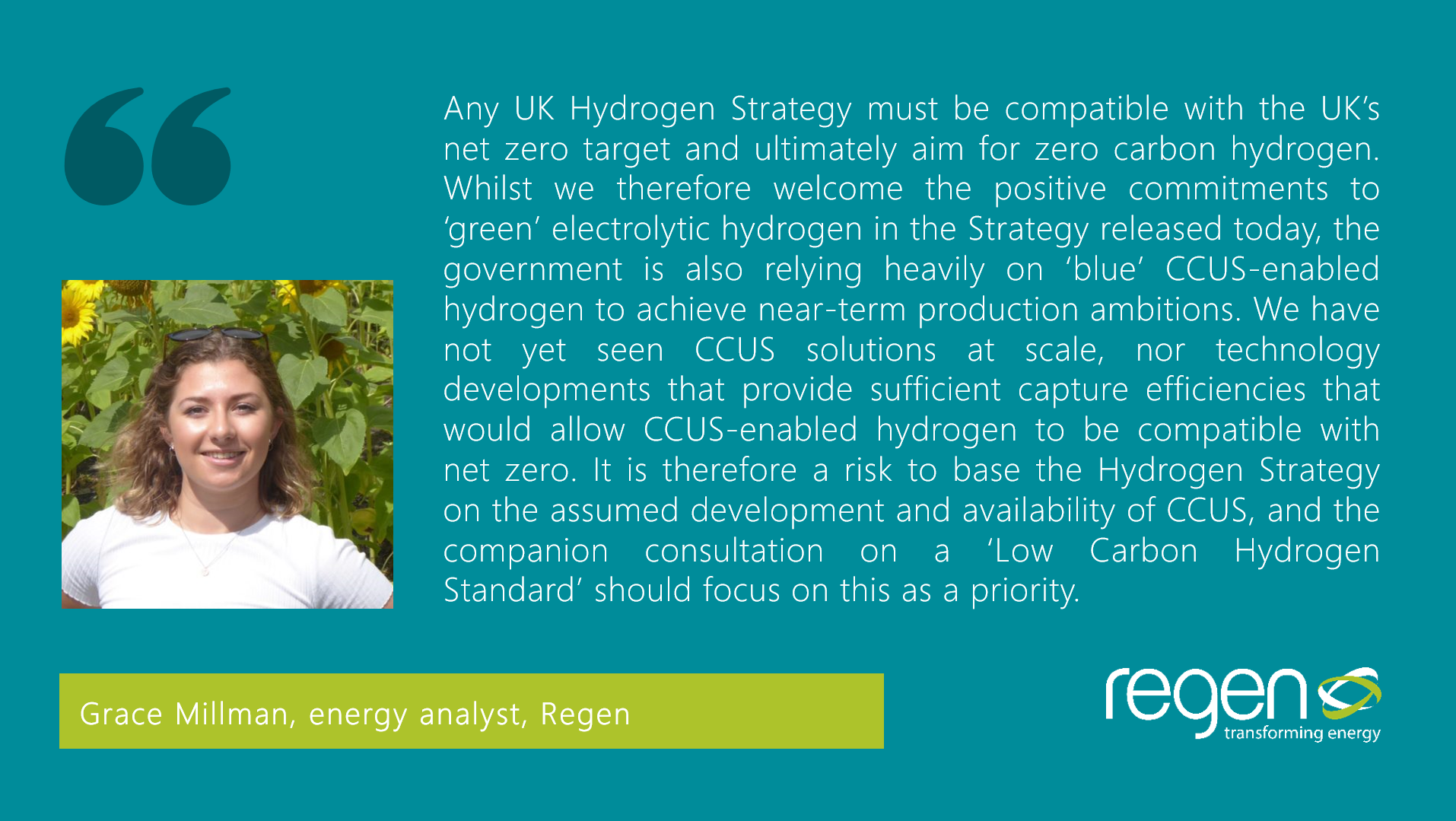As expected, the government’s Hydrogen Strategy is not a definitive strategy but more of a restatement of existing policy measures and targets, alongside a framework and timetable to make further decisions. To the credit of the officials that have worked in this area, this has been a long time in development, so it is great to finally see the strategy paper published as a starting point to work from.

There is a lot of detail in the document and the various consultation annexes, which we will come back to with more analysis in due course, but a first glance suggests that BEIS officials have been thinking hard about the future of hydrogen, its role in achieving net zero and the roadmap to enable the UK to be at the forefront of this new global industry.
Readers expecting an absolute and clear strategy may be disappointed. As is the way with government strategy documents, it is high on ambition but light on clear strategic direction. It does however provide a useful overview of the UK’s policies in the hydrogen space, together with a clutch of new consultations dealing with, amongst other things,
- The setting of hydrogen standards and the definition of ‘Low Carbon’ hydrogen
- Legislative and regulatory changes, including consumer protection, to allow for hydrogen heating trials
- Proposals to provide grant and subsidy support for hydrogen production business models
- More detail on the establishment of the Net Zero Hydrogen Fund
- Support for industrial and transport fuel transition
Overall, the strategy document restates the UK’s ambition to develop its hydrogen sector both as a major producer and consumer of hydrogen products. There is not too much controversy in the strategy, as expected there is a lot of focus on commitments and targets that have already been set and announced in the previous 10 Point Plan, including the target to significantly ramp up hydrogen production capacity to 5 GW by 2030. The strategy is perhaps light on the development of demand markets and new hydrogen applications. This is an area that will come back to bite if the UK ends up supporting early–stage producers without creating the markets into which hydrogen will be used.
We have summarised four high-level takeaways from the Strategy below and outlined where we believe the government should focus their efforts.
1) Low carbon hydrogen standards must be based on net zero outcomes

As previously announced the UK’s strategy is to be technology neutral when it comes to hydrogen manufacturing, preferring to focus on “low carbon” production rather than the various colours of hydrogen technology. This neutrality has a certain logic but carries the risk that the UK may back first-movers in the production space rather than focus on the ultimate preferred solution which, as the strategy acknowledges, is almost certainly green hydrogen produced via electrolysis using renewable electricity.
If the choice of production is technology neutral, setting the right standards and definition of what is low carbon hydrogen will be critical. We are pleased that the strategy includes a consultation on hydrogen standards, an important step to ensure that the UK maintains the highest standard for hydrogen production and supply. We also welcome the intention to consider the full lifecycle assessment of greenhouse gas emissions, as well as the maximum emissions associated with hydrogen production.
Our major concern is that the stated desire to adopt one single low carbon label may allow hydrogen produced with poor levels of carbon capture, or fossil fuel generated electricity, to be branded as low carbon and receive high levels of production support. There is an active discussion in the industry that blue hydrogen with carbon capture levels which are as low as 60% could be classed as low carbon, leading to emissions that would be only marginally lower than fossil gas.
This would be a mistake, allowing inefficient production processes to crowd out future investment in green hydrogen and more efficient blue hydrogen. We hope the government will stick to its declared intention to set the standard at a level that is consistent with the UK’s net zero commitments, which means that blue hydrogen must be substantially decarbonised with very high levels of carbon capture, and safe carbon storage, and the exclusive use of renewable electricity for green hydrogen.
2) Hydrogen heating has a long way to go
In another controversial area, the Hydrogen Strategy is very cautious about the use of hydrogen for heating. There is a commitment to make a key strategic decision by 2026, but there is little indication that the government is optimistic about its outcome. This is for a good reason; as our previous paper, 8 Critical Questions for Hydrogen Heating, highlighted, the use of hydrogen for heating faces some pretty big challenges, including the fuel cost and security of supply.
The Hydrogen Heating Consultation is not a consultation about the future of heating, but really a consultation on the legislative and regulatory changes required to allow hydrogen heating for a first village, town and eventually grid scale trials. The complexity of getting these trials underway, including the need for legislative changes and new measures to protect consumers, shows just how difficult any future grid conversion will be.
The decision date of 2026 is problematic. In one sense, it is too late; the UK urgently needs to deploy low carbon heating and energy efficiency measures to meet the government’s target to install 600,000 heat pumps per year by 2028 and, more importantly, to be on track for the 6th Carbon Budget. Right now, local authorities, housing associations, builders and communities are in a quandary about whether to press ahead with their decarbonisation plans. On the other hand, given the enormity of the hydrogen heat challenge, and the fact that trials will have only just started, it is very difficult to see how a decision can be made by 2026, and what new evidence will be available.
The real risk here is that the decision gets kicked down the road, especially if UK and devolved governments are unable to provide clear leadership in the face of continued industry lobbying, leading to delay in the deployment of energy efficiency and other decarbonisation measures.
3) Proposed business models (subsidies) for production support require more work
As we highlighted in our paper Building the Hydrogen Value Chain, the design of subsidy support for hydrogen production looks extremely tricky. Production subsidies must avoid locking in incumbent suppliers, with high cost and inefficient processes, who are then able to dominate the market.
The consultation document on hydrogen business models steps through all the variations of subsidy support regime that could be applied highlighting their benefits and numerous weaknesses.
The preferred, or minded to, option is a variation on a Contract for Difference (CfD) strike price, using the higher of the Natural Gas wholesale price or the Achieved Sales Price as a reference price. As the consultation acknowledges, this approach, which is only a temporary solution, has the major weakness of not incentivising producers to target higher value hydrogen applications, and may in fact lead to dumping of hydrogen to the lowest value/lowest cost customer – for example, through grid blending.
To address this, there is a proposal to add in some additional contractual terms, possibly with a gainshare incentive, to encourage producers to sell into high value markets. It all sounds horribly complex and is likely to be an administrative and budgetary nightmare.
It feels like officials have been given an impossible task to define something that looks like a CfD, because that is what worked in offshore wind and is now considered an acceptable subsidy design, but to apply it to an industry that has a completely different value chain and is at a very different stage of development.
The proposed design needs a lot more work through the consultation process, and will no doubt be subject to further review by the Treasury. If this arrangement is just going to be for the first couple of production plants, it may be better to provide a simpler revenue support subsidy or co-investment finance.
4) Additional policies to support hydrogen demand markets and new applications
As the strategy document highlights, hydrogen, and fuels derived from hydrogen, could have a key role to play in the decarbonisation of parts of industry and of transport, especially in heavy transport, industrial processes, speciality vehicles and the marine and aviation sectors. We therefore welcome that the government is supporting hydrogen innovation and the development of the sector.
The strategy includes a number of measures to support new hydrogen demand markets including a £315m Industrial Energy Transformation Fund and a £55 million Industrial Fuel Switching 2 competition to be launched later this year.
Overall, however the impression is that the hydrogen strategy lacks a clear, joined up, industrial strategy to support the development of new hydrogen applications and markets. A first priority should be to target grey hydrogen applications and convert these to low carbon alternatives. Without substantial demand growth any hydrogen strategy will be ineffective. This requires joined up government and collaboration across departments including transport, agriculture, and the devolved administrations.
If the strategy is driven by headline targets for production capacity, and under pressure from incumbent industry players who want to see support channelled to existing gas-based assets, it could fail to deliver the jobs and economic potential of the full hydrogen value chain. The result could see considerable public funding used to enable less efficient and less sustainable production processes, without developing the full hydrogen value chain and the jobs that have been promised.
Looking ahead
Over the coming weeks, we will be dissecting the Strategy and individual consultations in further detail, and will be focusing our asks of the government on ensuring that any future hydrogen scenario is realistic in its scale and clear about where hydrogen adds the most value over other decarbonisation options.
Over the past year, Regen has been looking in detail at the role that hydrogen can play within a low carbon energy system, specifically the government policies needed to make hydrogen-based energy solutions competitive and the strategy needed to provide investment in production and distribution infrastructure. Check out our current hydrogen work here, including our most recent project with Cornwall Council, which critically examines the role of hydrogen in a net zero economy and green recovery for Cornwall and the Isles of Scilly.
